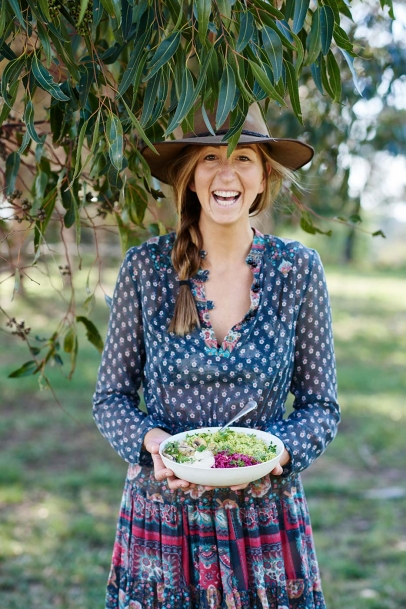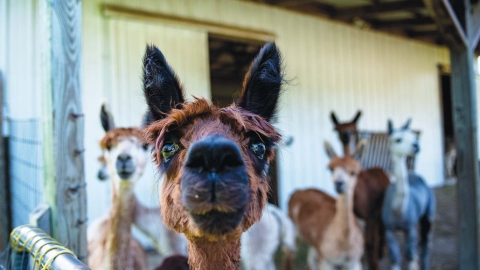Planted
Plant-based diets aren’t anything new—even if the concept is trending in 2020. And yeah, yeah, yeah, I used the word “trend,” but make no mistake … while plant-based foods are popping up everywhere from fast-food restaurants to local farmers markets—and world-wide everyone from big-name celebrities to high-profile athletes to everyday people is exploring the plant-forward lifestyle—this movement (if you will) is much more than a trend. En vogue, yes, but a trend? Nah, it’s much more than that, and people everywhere (myself included) are starting to consider making the trend a permanent part of their lifestyle.
But just how do you begin to explore a plant-based diet? Where do you start, and for that matter, why?
Harriet Birrell—known to her many followers simply as Natural Harry—plant-forward lifestyle advocate and successful cookbook author, has more than a few practical reasons why a plant-based diet is good for your body, mind and soul.
FROM FASHION DESIGNER TO WHOLE-FOOD CHAMPION
“Lucky for me,” says Birrell of her upbringing, “we ate a very basic diet of whole foods. We had very few treats or rather, healthy and whole foods were considered treats to us. I grew up on my grandparents’ farm 40 minutes from the closest big town so we tended to not have access to local shops and restaurants so most of our diet was homemade goodness, from scratch.”
But while she has always had a diet rich in whole foods with little to no processed food, she hasn’t always followed a 100 percent plant-based diet. Nor has she always been a shining example of what most would consider healthy.
“I really began to disregard my health,” says Birrell of the years she spent working in the fashion industry in Melbourne, Australia.
“The high-pressure, high-stress environment caused me to focus more on convenience foods rather than whole food,” she says. Eventually, the lifestyle got to her and she left her job and city life behind to travel for six months. When she returned home, she took a leap of faith and turned her attention to what she says was always her original passion: health and wellness. She enrolled in a 12-month online course at Integrative Nutrition. During that time she was quickly drawn to the organic, plant-based whole foods approach.
“It just makes so much sense to me that whole is better than processed and variety, color and natural is vitality and sustenance.” And, she says, after committing to a 100 percent plant-based diet, she began to take heed of the changes to her body, mind and overall well-being.
“I noticed an increase in energy and clarity of mind,” she says. “I have always been a swimmer but [after following a strict plant-based diet] was able to swim much farther and faster without tiring. It’s like I have more oxygen in my blood... if that’s possible.” Along with physical changes, Birrell soon recognized a sensitivity to processed foods and says there is a big contrast between knowing what good health actually feels like and what it doesn’t.
Bottom line, feeling good is the main reason she says she chose to walk this path, and looking after herself on a cellular level so she can be her best version for the people she loves is why she continues.
NATURAL HARRY’S TOP FIVE TIPS FOR LIVING A MORE PLANT-FORWARD LIFE
Interested in exploring a more plant-forward lifestyle? Here are a few tips to get you started:
- Arm yourself with the best recipes and books. Get in the kitchen and reteach yourself to cook plant-based whole foods.
- Only make meals you enjoy and that satiate you. Make sure to eat enough whole-food, plant-based protein from beans, nuts, seeds, legumes and grains.
- Fill your fridge and pantry with plant-based whole-food ingredients and challenge yourself to use all of it.
- Put some music on and make mealtime cooking a therapeutic and fun experience. Enjoy it!
- Go at your own pace. If replacing just one meal a week to begin with is a good start for you, do that.
VEGAN VS. PLANT-BASED
“Veganism,” according to the Vegan Society, is a way of living “which seeks to exclude, as far as is possible and practicable, all forms of exploitation of, and cruelty to, animals for food, clothing, or any other purpose.” In other words, veganism isn’t just a diet, it’s a lifestyle. As for the diet part, vegans do not eat any animal products, including not just meats but also all dairy products eggs and even honey. And vegans, like those who follow a plant-based diet, eat a combination of fruits, vegetables, whole grains and legumes. However, a plant-based, or plant-focused, diet does not necessarily mean excluding all animal products, but generally speaking, those on this path do get 85–100 percent of their nutrition from plant products.
IS PLANT-BASED PROTEIN AS GOOD AS ANIMAL PROTEIN
Yes, says professional athlete and sports nutritionist, Griff Whalen - Photography courtesy of Grill Whalen and the Indianapolis Colts
Griff Whalen, former Indianapolis Colts wide receiver, knows a thing or two about fueling his body for prime performance. The professional athlete, who now follows a plant-based diet, says he’s stronger and more efficient both on and off the field than ever, but he hasn’t always been a plant-forward eater.
“Growing up my diet was pretty typical for middle-class Americans, which is another way of saying it was terrible. Especially as I gained more independence in high school and relied less on home-cooked meals. Almost everything I ate was heavily processed and oversaturated with sugar and fat.”
In college, Whalen says he gradually began to learn how important nutrition was and how large a role it plays in athletic performance and development.
“I started eating more natural foods, lean meats, more vegetables, but still to this day struggle with self-control when it comes to sugary foods. Personally, I feel that I ate so much sugar as a kid and in high school that I developed a strong addiction to it, and now I try to avoid it as much as possible, much like an alcoholic does with alcohol.”
Signed to the Colts in 2012, Whalen went on to play for other teams, including the Oakland Raiders, and it was during his time there that he met sports dietitian Rikki Keen MS, RD, CSSD, CSCS. In addition to working with the Raiders, Keen has worked with NFL veterans and draftees at ESPN’s “Wide World of Sports,” the USWNT (U.S. Women’s National Team) and currently serves as director of performance nutrition for the Orlando City Soccer Club.
“I work with individual athletes and teams on adequate fueling, hydration and supplementation, planning
out menus, monitoring blood work, conducting body composition and pre- and post-nutrition for training and game days,” says Keen. And, she says, offering plant-based protein sources at each meal, which includes food sources, as well as supplement options, is key to building and maintaining the muscle needed for high-level performance.
“The nutrients we focus on around training are leucine, creatine and quality carbohydrates,” says Keen, as well as those derived from colorful fruits and vegetables, healthy fats, fortified B12 and calcium sources, and probiotics. And the vegan players says Keen—like current USWNT member Alex Morgan and former player and three-time Olympic gold medalist Heather Mitts—can obtain essential omega 3s from an algae-based supplement.
Edible Indy: When did you first get interested in following a plant-based diet?
Griff Whalen: I believe it was 2013 or 2014. I saw a documentary called “Engine 2 Kitchen Rescue, and I was intrigued by the plant-based diet it was promoting. They had a website with guidelines for a 28-day plant-based challenge, and I was always looking for ways to improve my nutrition, so I thought I would give it a try. This was the first time I was really exposed to any information regarding plant-based diets.
EI: Ultimately, what was the reasoning behind making this lifestyle choice? Some people are vegan because they don’t believe in eating animals while others live this way more out of a concern for the planet and their overall health. What is it for you?
GW: I made the switch almost entirely for athletic performance reasons. I could feel an incredible difference when I started eating this way, and my motivation was to help my football career by improving recovery, blood flow, endurance, speed, strength and overall performance. Only over time did I become aware of the tremendous environmental impacts, long-term health benefits and, obviously, animal rights.
EI: Have you noticed an upsurge in both professional athletes and “everyday” athletes exploring the idea of following a plant-based diet?
GW: I know a fair amount of the other vegan athletes out there.
RK: Yes, there has been an increase of athletes from all levels wanting to go more plant-based and vegan. It varies on how an athlete will approach what I call the plant-based journey—usually it starts with removing red meat and pork, then dairy and or chicken, to no animal products at all.
EI: How does someone make the switch? Gradually?
RK: Identify the nutrients that will be limited in the foods that are omitted. Make a plan on how these nutrients will be replaced, some may need to be supplemented. Some people make a spur-of-the-moment decision to go vegan or plant-based; I recommend starting off with selecting a meal each day or a full day each week, then building from there. It’s more enjoyable and most likely to stick, as well as gives one time to navigate the key nutrients of concern.
GW: I switched overnight to the Engine 2 plant-based diet and followed it for their entire 28-day program. I really had no intentions of permanently adopting a plant based diet, I just wanted to do the 28 days as a sort of healthy, cleansing type of experience. After a week or two, however, I felt a more dramatic improvement in my body than I could have imagined. I didn’t even think I felt bad or anything before starting, but as I went along I started to feel significantly more energetic and alert. I felt lighter, and found it easier to breathe and recover while training. I could feel my joints become less stiff and achy, which again I wasn’t even aware of how bad they had felt before. All of this convinced me that I was onto something, so I started researching plant-based diets for the first time. When the 28-day program ended I decided I would continue with a plant-based diet with the exception of including some fish. The fish made me feel more comfortable about getting enough protein, but as I continued my research I learned I could get all the protein I needed from plants and avoid some of the toxins and negatives that come with eating fish, so I cut fish back out of my diet after a month or two, and resumed eating completely vegan from that point on.
EI: What did trainers, coaches or even other athletes make of your decision to follow a plant-based diet?
GW: At the time I was the only completely plant-based NFL player, so this was a bizarre idea to most. Trainers seemed mostly skeptical, but nutritionists were a little more comfortable with it, understanding that as long as we paid attention to getting the right nutrients I could thrive on this diet. Other athletes found it pretty strange as well, but expressed more and more curiosity over time, especially as this diet became more mainstream for athletes.
EI: And what about protein … I have heard this is [perhaps] the biggest hindrance for athletes wanting to explore the lifestyle; many worry they won’t get sufficient amounts of protein to maintain the physical strength and endurance, their body needs.
RK: It just takes effort. It can be easily done knowing what, when and how much of plant-based proteins to include in the diet and if needed, add a plant-based protein powder [shake] when eating a meal is not desired. There is a difference in the amino acid profile between animal- and plant-based proteins; the key is getting more of the plant-based protein to equate to the animal-based protein. So, [instead of] eating three ounces of meat, a plant-based athlete would need to eat two cups of beans to obtain enough of a key amino acid, leucine, to trigger muscle protein synthesis. Ideally, hitting this threshold every three to four hours to maintain optimal levels for muscle adaptations.
GW: Most of us have been conditioned our entire lives to think as athletes we need tons of protein, and we should get it from meat, chicken, fish, milk or chocolate milk. In reality, it’s pretty easy to consume too much protein, especially eating lots of animal products, and this is actually detrimental to your health. Of course you do need protein, and athletes with intense training need more than the average person, but you can easily get all you need from plants. All plants have some protein but richer sources include lentils, beans, rice, garbanzo beans, quinoa, kale, spinach, nuts and seeds.
EI: So all in all, has it become easier to follow a plant-based diet over the last few years, now that there are so many more options readily available?
GW: Yes and no. It has certainly become easier socially, with so many restaurants now offering options, and with tasty plant-based versions of just about any food, it’s pretty easy to eat out, or to cook plant-based foods that people on any diet will enjoy. It’s also much easier now when traveling to find plant-based options in most places. The downside, though, for me is that so many plant-based restaurants and products sacrifice nutrition for taste in order to compete with their non-vegan counterparts, so while they’re still plant-based, they can be quite unhealthy by containing large quantities of oils, sugars and chemicals. This is great for convincing meat eaters that they could be happy eating plant-based, or for those who care about the environment or animal rights but not necessarily nutrition, but now you can’t really assume that something is healthy just because it is plant based.
EI: What’s one piece of advice you’d give someone (athlete or not) who’s considering following a plant-based diet?
RK: No matter if one goes plant-based or not, eat less processed and more real food. Use the dirty dozen as a guide for buying organic produce.
(According to the Environmental Working Group, these 12 foods are the most contaminated and consumers should opt for organic options whenever possible: strawberries, spinach, nectarines, apples, peaches, pears, cherries, grapes, celery, tomatoes, sweet bell peppers, potatoes.)
GW: For most people this is a massive lifestyle change. Food is typically a focal point of many social events, and family traditions and holidays. This can make changing the foods you eat complicated and even uncomfortable in some situations. I don’t think it’s a super simple change, and my best piece of advice is to gather some good resources right away, maybe even before you start. Resources like recipes, meal plans, nutritional and health information, and other people who eat plant-based will be immensely helpful, because there is a real learning curve to making this big of a change to what you eat—though I think the change is entirely worth making!

RIKKI KEEN’S GO-TO SNACK FOR THOSE WANTING TO EAT MORE PLANT-BASED FOODS:
“performance balls and frozen blueberry bowls, similar to acai bowls. Performance balls, aka energy bites, are so easy to make and you can change up the ingredients as you like. Ingredients include peanut butter, ground flax seed, rolled oats, vanilla extract, dark chocolate chips and honey. Bowls are always popular, as athletes (or non-athletes) can personalize toppings: berries, bananas, chia seeds, flax seed, peanut butter, coconut flakes, dark chocolate chips, and granola.”
NATURAL HARRY’S ESSENTIAL PLANT-BASED PANTRY
Activated buckwheat: made from buckwheat seeds, used in baking recipes
Apple cider vinegar: a prebiotic vinegar used as a tonic; purchase brands that are raw
Black bean spaghetti: tender and loaded with protein, great alternative to wheat-based pasta
Cacao nibs: use instead of traditional chocolate chips, high in antioxidants
Cacao powder: adds a smooth chocolate flavor to smoothies and more
Chia seeds: high in omega-3s
Chickpea flour: aka besan, great when used to bake pizza crusts, cakes and cookies
Coconut aminos: made from fermented coconut blossom, similar to soy sauce but with lower sodium
Coconut yogurt: made from cultured coconut milk
Food-grade essential oils: look for orange and peppermint
Kelp noodles: made from sea kelp, loaded with nutrients
Kimchi
Kombucha
Maple syrup
Medjool dates
Miso
Mung bean fettuccine: also known as cellophane noodles
Nori: edible seaweed
Nutritional yeast: an inactive yeast grown in molasses, it lends a “cheesy” flavor to recipes
Organic rolled oats
Plant-based milk
Purple sweet potato: aka okinawan, tons of fiber and nutrient dense
Sauerkraut
Smoked paprika
Tahini: paste from sesame seeds lends a nutty flavor to dishes
Tamari: similar to soy sauce but with a smoother, thicker consistency
Tempeh
Tofu
Vanilla powder: make sure the brand’s only ingredient is vanilla bean (no added sugar)
Wakame: edible sea vegetable, great in salads and soups
Illustration created by Caryn Scheving.









